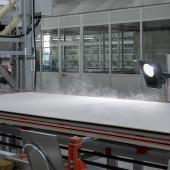The Phase 2 of the ceramic industry
Ceramic tile manufacturers, colour and glaze companies and machinery and plant suppliers are all back to work counting on their respective competitive factors to overcome a challenging situation.
Following lockdowns of various durations the world over, in April and May the ceramic industry gradually got back to work in a patchwork fashion, although ceramic producers and the suppliers of technologies, raw materials and glazes, have already paid a high price in these first months of the year.
After getting off to a good start to 2020, between March and April, the Italian ceramic tile industry lost 350 million euros out of a total annual turnover of 5.34 billion euros.
In Spain according to the Spanish tile manufacturers’ association Ascer, in April the ceramic tile industry suffered a 160 million euro loss of revenue, a decline of 45% compared to April 2019.
In the United States, where there were already signs of weakness for flooring material in general in the first quarter of the year, “it’s easy to expect a much more significant drop in sales especially during Q2 and Q3”, said Gianni Mattioli, president of Tile Council of North America.
There are fears also among Spanish and Italian glaze and colour producers, which have been impacted by the sharp fall in demand. In Spain, the national trade association Anffecc reported that sales in April fell by 40% compared to the same month in 2019, including a 49% drop in the domestic market and a 37% decline in exports. “But the decline in turnover in May could prove even more severe if demand fails to pick up rapidly in both the Spanish and foreign markets”, said Joaquín Font de Mora (Chairman of Anffecc),
The contraction in revenues reported in April by the Italian glaze and colour producers is more or less of the same order of magnitude, as confirmed by Claudio Casolari, Chairman of Federchimica-Ceramicolor.
As for the ceramic plant and equipment suppliers, they are well aware that they will have to wait patiently for the international customers’ investment projects to start up again, but they are also ready to count on several competitive factors that will help overcome even such a challenging situation. This was confirmed by Paolo Sassi (Chairman of the Italian Ceramic Machinery Manufacturers’ Association Acimac). On the one hand, the longstanding internationalisation and availability of parts warehouses and sales and technical support branches in key markets is allowing Italian companies to quickly grasp opportunities wherever they arise. On the other hand, Industry 4.0 automation has proved crucial for keeping in touch with even the most distant customers, providing not only constant tele-support but also remote installations and virtual start-ups, remote plant testing of complete automated lines, all of which have been completely successful.
Did you find this article useful?
Join the CWW community to receive the most important news from the global ceramic industry every two weeks





















